Homemade Sourdough Bread, Step by Step
This post may contain affiliate links. Please read my disclosure policy.
If you love fresh sourdough bread with a golden, crisp crust and a light, airy crumb, this recipe is for you. It’s one of the simplest homemade sourdough bread recipes, and one of the best, too. It requires only 25 minutes of hands-on work and no autolyse or preferment. Below you will find guidance for every step of the way. 🍞🍞🍞
⭐️⭐️⭐️⭐️⭐️ Review:
“Absolutely the best sourdough recipe EVER! I have been baking bread for years (sourdough included,) and things were many times hit or miss. Not with your recipe. You have nailed it. I thank you!” — Rosemary Patterson
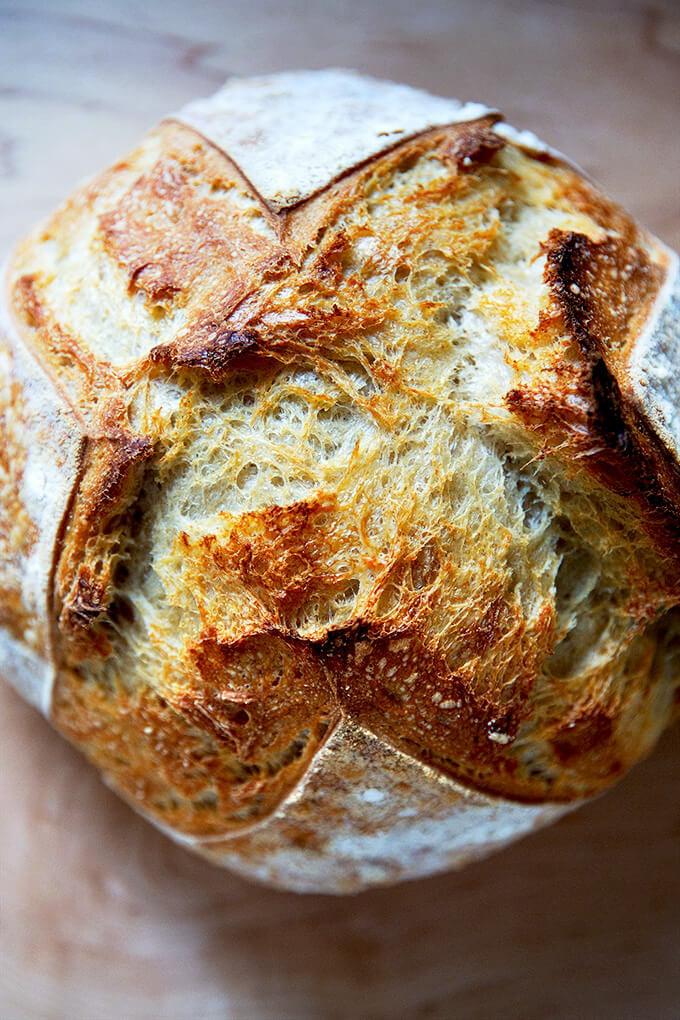
This post will show you how to make the simplest of simple sourdough breads. There is no autolyse or preferment, which means the dough itself comes together in less than five minutes.
For those intimidated by sourdough bread baking, this recipe, as well as this sourdough focaccia recipe, are the recipes I suggest making first, both for their simplicity and flavor. Another great beginner’s bread recipe to try is this overnight, refrigerator focaccia or my mother’s simple peasant bread recipe, both of which require minimal effort but yield spectacular results.
This post is divided into 13 sections:
- What is Sourdough Bread?
- What is a Sourdough Starter?
- How to Feed a Sourdough Starter
- When is My Starter Ready to Be Used?
- Equipment
- How to Make Sourdough Bread: A 5-Step Overview
- How this Sourdough Bread Recipe Differs From Others
- Simple Sourdough Bread: A Step-by-Step Guide
- #1 Sourdough Bread Baking Tip
- Troubleshooting: Where Sourdough Goes Wrong
- Sourdough Baking Resources
- Other Sourdough Bread Recipes to Make
- Sourdough Bread Baking Schedule
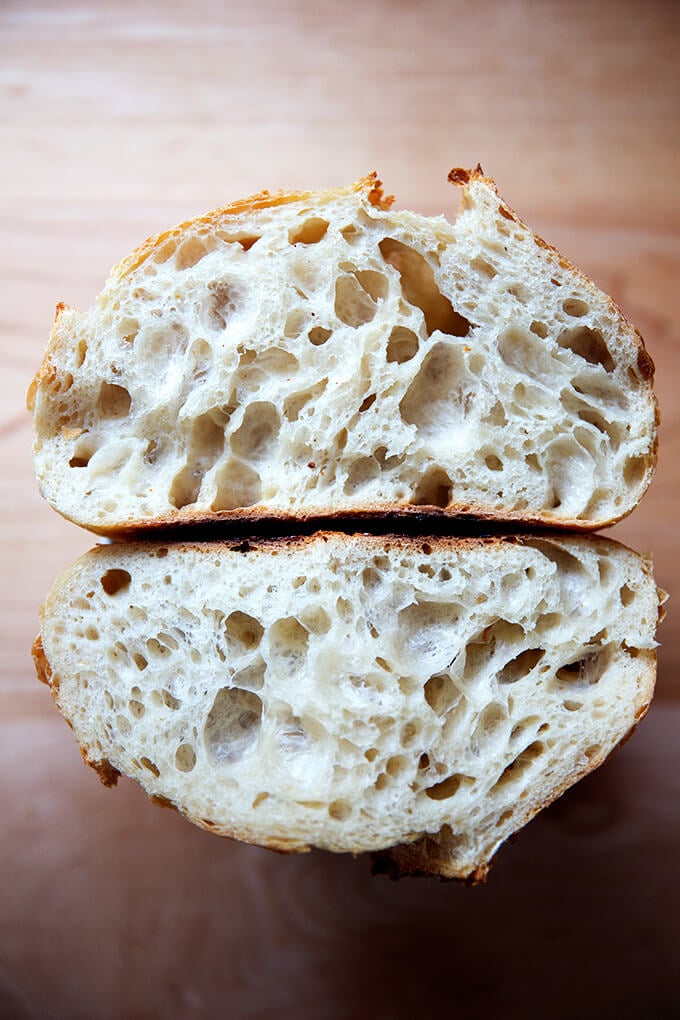
What is Sourdough Bread?
Sourdough bread is bread that has been leavened naturally, meaning it has been leavened by a sourdough starter as opposed to by commercial yeast or a chemical leavening agent such as baking powder or baking soda.
What is a Sourdough Starter?
A sourdough starter is a fermented mix of flour and water containing wild yeast and bacteria (lactobacilli). Provided it is healthy and active, a sourdough starter is what will make your bread rise.
You can make a sourdough starter from scratch in just about a week. I only recommend doing so if it currently is summer (or a very warm fall) where you are. While it is immensely satisfying to build a starter from scratch and subsequently use it to make a beautiful loaf of bread, I am a huge proponent of purchasing one for a few reasons, namely: when you purchase a starter, you are guaranteed to have a strong, vigorous starter from the start. In other words, you can start baking with confidence right away.
Here are three online sources for reasonably priced sourdough starters:
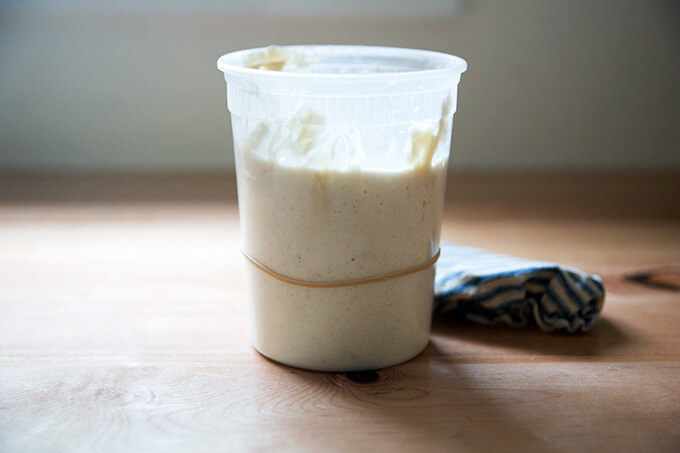
How to Feed a Sourdough Starter
In order to keep your starter alive, you have to feed it — it’s not unlike having a pet, but know this: caring for a sourdough starter is akin to caring for a very low maintenance pet, one that requires feeding only once every two to three weeks to stay alive, but one that requires feeding much more regularly if you like to bake frequently.
When I am not baking regularly, I store my starter in the fridge in the above-pictured vessel with its lid on. As noted above it can hang out there for 2-3 weeks (if not longer) without being touched. To wake it up or activate it, I like to feed it twice before using it. Often I’ll remove it from the fridge after dinner and feed it: this involves discarding most of it and replenishing it with equal parts by weight flour and water. (Please read this post, which explains in detail how to activate, feed, and maintain a starter.)
I will repeat this process in the morning — discard most of it; then replenish it with equal parts by weight flour and water. By midday, or when my starter has doubled in volume, it is ready to be used.
To store your starter, you should feed it, let it rise till it nearly doubles; then cover it and stash it in the fridge for 2 to 3 weeks until you are ready to use it again.
How Do I Know if My Starter is Ready to be Used?
If your starter doubles (or triples!) in volume within 4 to 8 hours after a feeding, it is ready to go. And ideally, you want to use your starter 4 to 8 hours after you feed it or when it has doubled. Every time I feed my starter, I place a rubber band around the vessel it is in to mark its height. This helps me see when it has doubled in volume and is, therefore, ready to be used.
If your starter is not doubling within 4 to 8 hours of feeding it, you should spend a few days strengthening it. This will involve discarding most of it — truly, don’t be afraid to be aggressive with how much you are discarding — and replenishing it with equal parts by weight flour and water. If you do this twice a day for several days, your starter will be in great shape.
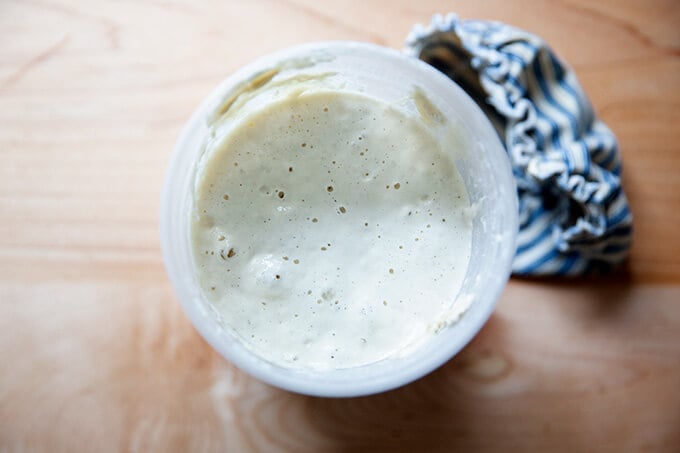
What Equipment Do I Need?
At a minimum, you’ll need:
- a sourdough starter (see above)
- flour, bread flour if possible, my preference is King Arthur Flour
- salt
- water
Ideally, you’ll also have:
- digital scale
- straight-sided vessel for monitoring the bulk fementation
- bench scraper
- flour sack towels
- parchment paper
- banneton, such as this one or this one
- razor blade
- heavy lidded vessel, such as this one or this one
How to Make Sourdough Bread: A 5-Step Overview
There are essentially 5 steps to making sourdough bread. Each of these steps is explained in more detail below.
- Mix the Dough: This is simply a matter of combining water, sourdough starter, salt and flour in bowl, and stirring to form a sticky dough ball.
- Bulk Fermentation: This is just a fancy name for the first rise. During the first two hours of the bulk fermentation, you’ll perform a series of stretches and folds, which will give the dough strength and elasticity.
- Shape + Bench Rest: This step ends the bulk fermentation. You’ll shape the dough, let it rest, then shape it once more.
- Proofing the Dough: In this recipe, you’ll cold proof the dough in the fridge, ideally for 24 to 48 hours, though you can get away with a shorter proof.
- Scoring + Baking the Dough: After the dough has proofed, you’ll turn it out onto a piece of parchment paper, score it; then transfer it to a preheated baking vessel.
How This Sourdough Bread Recipe Differs From Others
This recipe differs from others in three main ways:
- No Autolyse. Why? I’ve never found employing an autolyse makes a big difference in the final texture of the bread, and I find the process of doing an autoylse frankly to be kind of a pain. What is an autolyse? Autolyse is a technique that calls for mixing flour and water together and allowing them to sit for several hours before adding the salt and sourdough starter. This process allows gluten to develop in dough prior to mixing. It also makes the dough more extensible. This is due to the hydrating effects of soaking the flour, as well as — and this is getting a bit scientific — from the enzymatic activity of protease, which breaks down some of the gluten that forms as the dough hydrates. This process weakens the dough’s elasticity, in turn increasing its extensibility. If you are after a super open crumb, autolyse is something to consider.
- 50% (roughly) Increase in Volume. If you come from the yeast-leavened bread world, you are accustomed to letting your dough double in volume during the first rise. When I first got into sourdough, I was applying this same method, and while I had success, I realized I was often letting my dough overferment — I was pushing the bulk fermentation too far. As soon as I stopped the bulk fermentation when the dough increased by 50-75% in volume, I got a much better oven spring.
- Long Cold Proof. After the bulk fermentation, you’ll shape the dough, and store it in the fridge ideally for 24 hours but it can hang out there for 48 hours or even a bit longer. This long, cold proof will make for a much lighter, open, airy crumb. (Note: If you were to leave the dough in the fridge for 12 hours or less, which you can do, the crumb will be tighter and denser.) After you remove the dough from the fridge, you score it, and transfer it immediately to the oven — there is no need to do a room temperature proof first.
Simple Sourdough Bread: A Step-by-Step Guide
Mix the dough.
To start, pour 375 grams of water into a bowl:

Add 50 to 100 grams of sourdough starter.
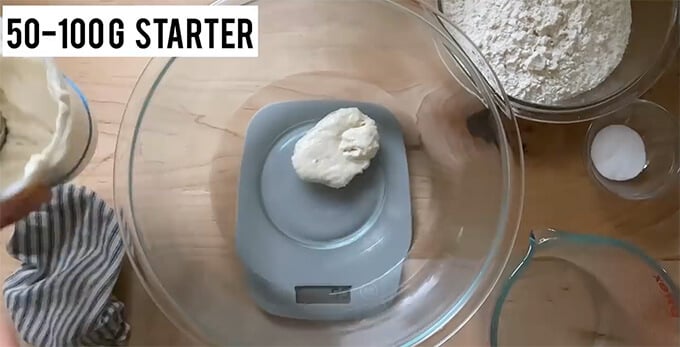
Stir to combine; then add 11 grams of salt:
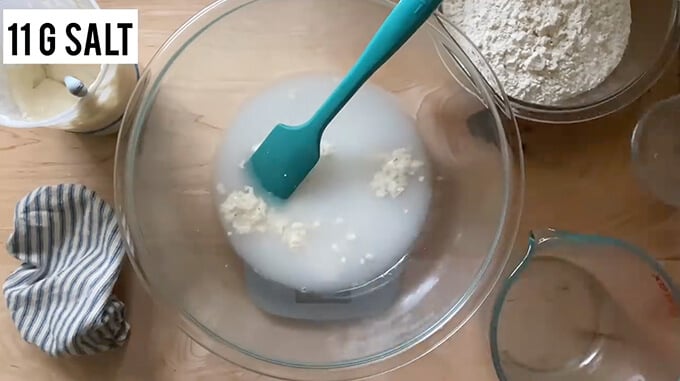
Finally, add 500 grams of bread flour:
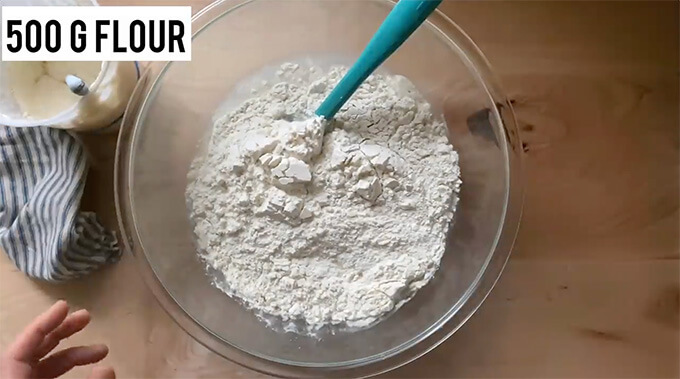
Stir to combine:
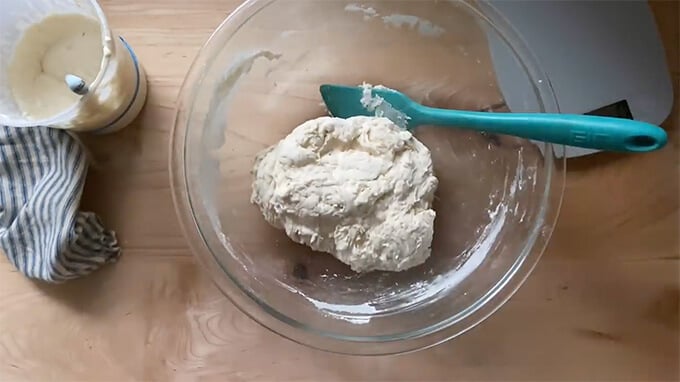
Let it Rise. (Bulk Fermentation)
Transfer the dough to a straight-sided vessel. Cover it, and let it rest for 30 minutes.
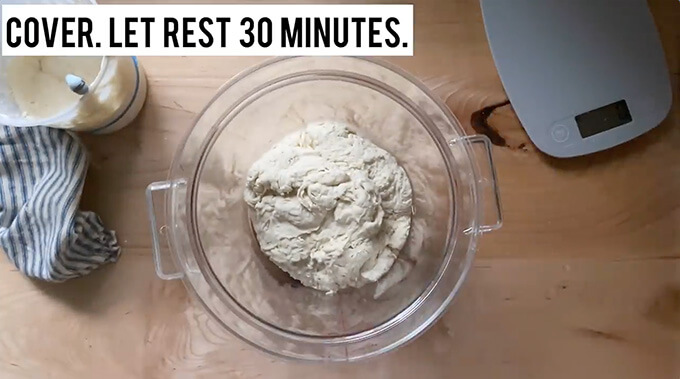
Perform a set of stretches and folds:
If time permits, perform four total sets of stretches and folds every 30 minutes for the first 2 hours. You should notice the dough getting stronger and more elastic with every set of stretches and folds. This is the 4th set:
After the 4th set of stretches and folds, cover the vessel — I love these Dot and Army cloth bowl covers for this — and set it aside until it increases in volume by 50% or so.
How long should the bulk fermentation take?
The time will vary depending primarily on the strength of your starter and the temperature of your kitchen. Rather than rely on a time period, however, you should rely on visual cues.
This video shows the dough nearly doubling (increasing by 100%) in volume, but the more I bake sourdough, the more I realize I have better success when I stop the bulk fermentation when the dough increases by 50%. It may take some trial and error to know what works best for you. You may find a 75% increase in volume is best or you may find that to be too long. Sourdough is all about experimenting and adapting based on your experiences.
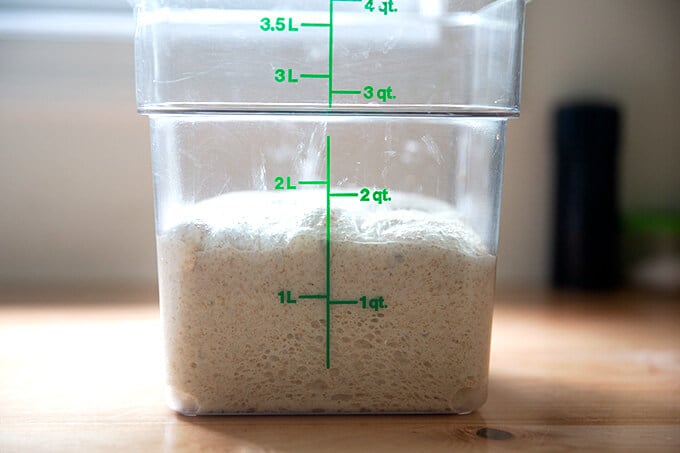
Shaping
Turn the dough out onto a lightly floured work surface:
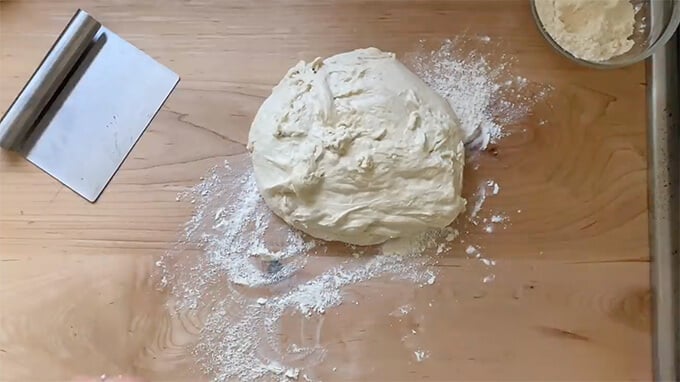
Shape the dough gently into a round and let it rest for 20-40 minutes. This is called the bench rest.
Meanwhile, prepare a bowl or banneton with a flour sack towel and rice flour.
Proofing
Shape the round again; then place in prepared bowl for proofing. Transfer to fridge for 12 to 48 hours.
Bake It.
Remove bowl from fridge, and turn it out onto a sheet of parchment paper.
Score it.
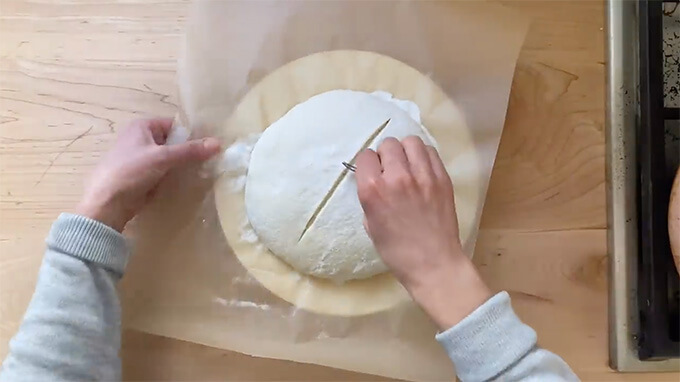
Transfer to preheated Dutch oven. Bake covered at 450ºF for 30 minutes; uncover, lower the temperature to 400ºF, and bake for 15 minutes more:
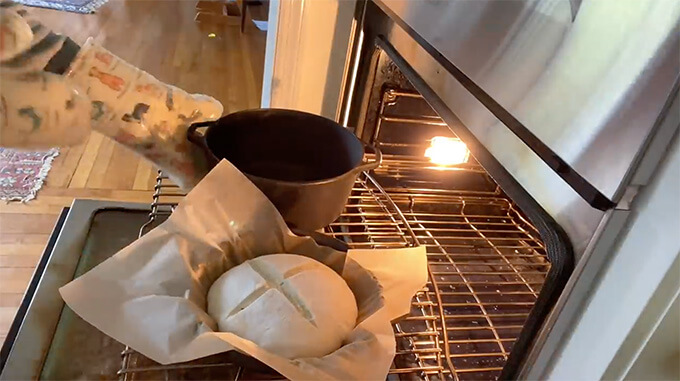
Remove from oven and let cool one hour before slicing.
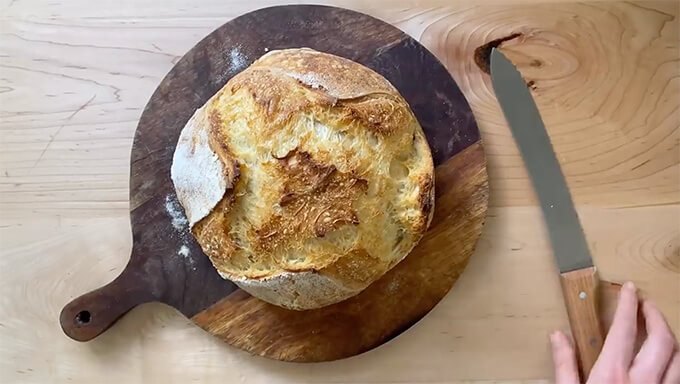
You’ll need a sharp knife (like this one or this one) when it’s time to slice:
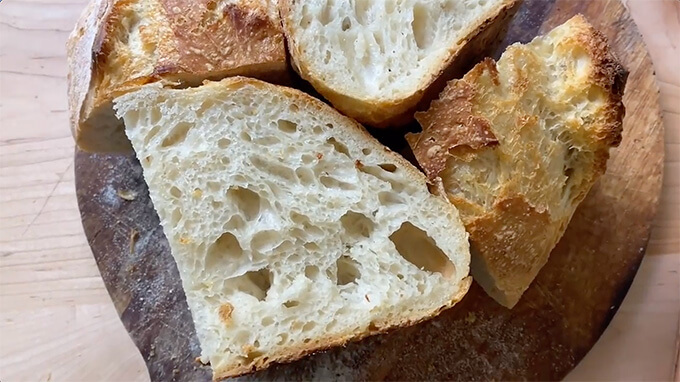
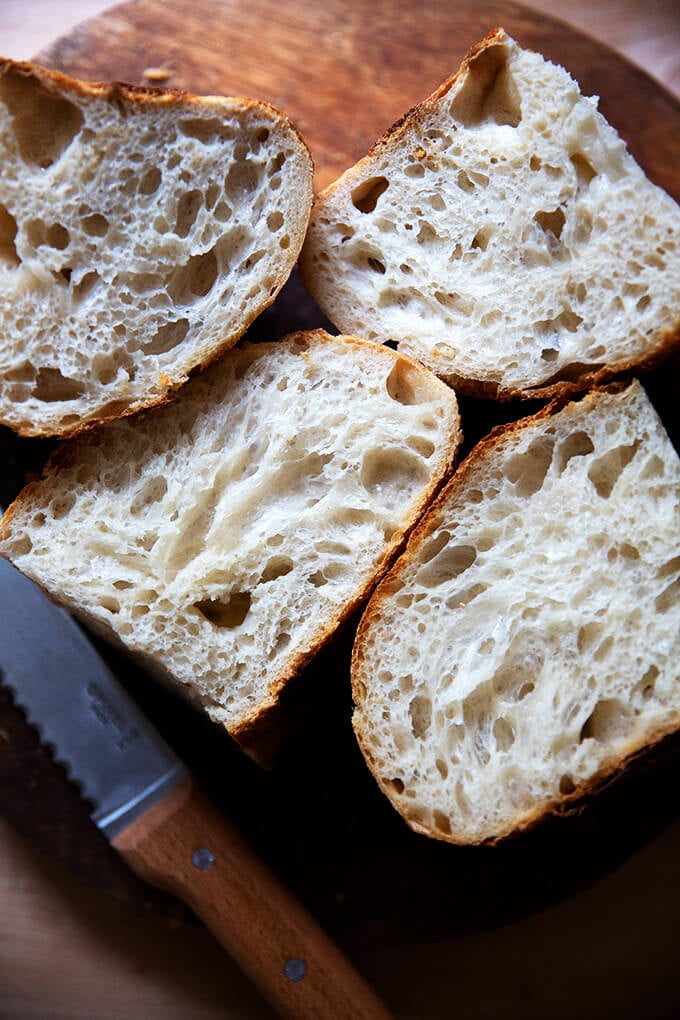
#1 Sourdough Bread Baking Tip
The refrigerator is your friend. Use it.
The most common mistake I see people make when making sourdough bread is letting the bulk fermentation go too long. They mix the dough at night; then wake up to dough that has tripled in volume and is a sticky mess.
To prevent over fermenting your dough, use your refrigerator as needed. After you complete the 4 sets of stretches and folds, you can put your dough in the fridge at any time. If you are tired and need to go to bed, transfer the dough to the refrigerator; then pick up where you left off in the morning: remove the dough from the fridge and let it continue to rise until it increases in volume by roughly 50%.
To accurately gauge when your dough has risen to roughly 50% in volume, I highly recommend investing in a straight-sided vessel such as this 4-qt Cambro (or this one, which is BPA-free!). When dough rises in a bowl, judging when it has risen sufficiently is tricky. There’s no question with a straight-sided vessel.

Troubleshooting: Where Sourdough Goes Wrong?
If you have ever had trouble baking sourdough bread, your issues likely stem from one of four places:
- Using a weak starter or not using starter at its peak.
- Using too much water relative to the flour.
- Over fermentation: letting the bulk fermentation (first rise) go too long.
- Using too much whole wheat flour, rye flour, or freshly milled flour.
I address each of these issues in this post: Why is my sourdough so sticky? 4 Common Mistakes, so please give it a read if you’ve had trouble with sourdough bread baking.
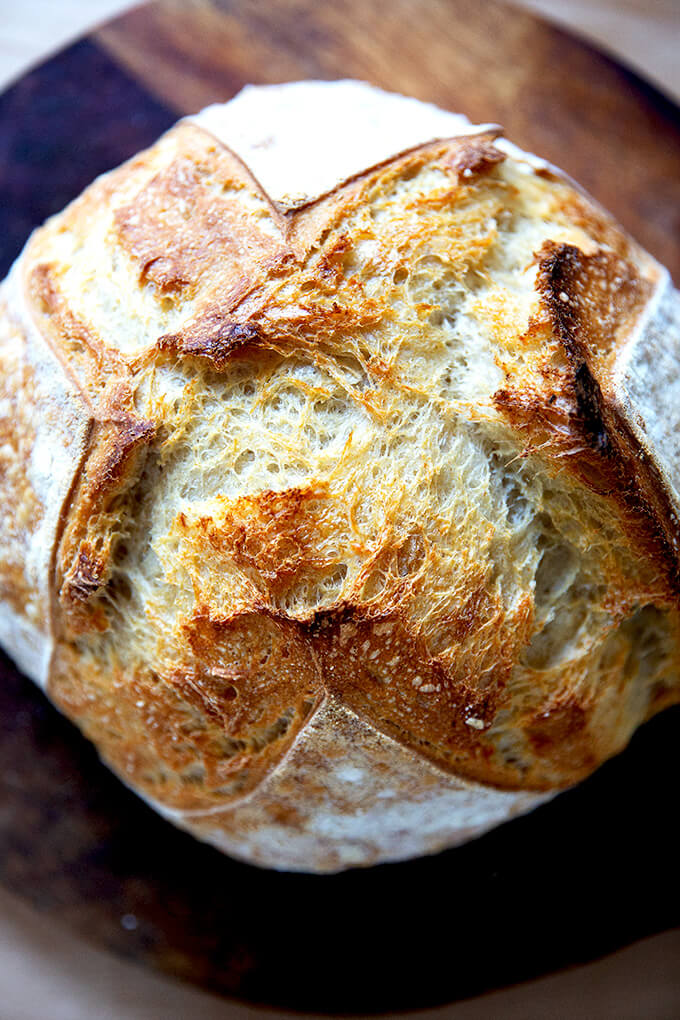
Sourdough Resources
- Sourdough Troubleshooting: This post addresses 4 common mistakes people make when baking sourdough bread and answers many FAQ’s as well.
- The Nutritional Benefits of Sourdough Bread + 6 Healthy Toast Topping Ideas
- Feeding Your Sourdough Starter
- Essential Equipment For Sourdough Bread Baking
- A tip for getting a more open crumb? Shape a batard as opposed to a round:
Other Sourdough Bread Recipes to Make
- Simple Sourdough Focaccia
- Sourdough Bread, Whole Wheat-ish
- Simple Sourdough Pizza
- Sourdough Detroit-Style Pizza
- Simple Sourdough Sandwich (or Toasting) Bread
- Sourdough Ciabatta
- Two Sourdough Discard Recipes: Sourdough Flour Tortillas & Irish Soda Bread
Sourdough Bread Baking Schedule
If you are new to sourdough bread baking, the timing of it all may feel overwhelming — you may find yourself asking: How can I do this without baking at midnight?
It’s a very good question! As noted above, your biggest friend when it comes to sourdough bread baking is your refrigerator. If after you’ve performed your stretches and folds, you don’t have time to stay up for the dough to complete the bulk fermentation, stick the vessel in the fridge and pick up where you left off the next day or the day after that.
Here is a rough schedule I like to follow. Adapt it to work for you:
Wednesday Evening: Remove starter from fridge. Feed it by discarding most of it and replenishing it with equal parts by weight flour and water.
Thursday Morning: Feed starter by discarding most of it and replenishing it with equal parts by weight flour and water.
Thursday Afternoon: Mix dough, let it rise. On Thursday evening, when the dough has completed the bulk fermentation, I’ll shape it and stick it in the fridge to proof. (As noted: If the dough hasn’t completed the bulk fermentation, I’ll stick the vessel in the fridge, and pick up where I left off the following day.)
Friday Evening or Saturday Morning: Score and Bake it. There is no need to let the dough come to room temperature before baking it. Simply remove it from the fridge, turn it out, score it, and bake it!
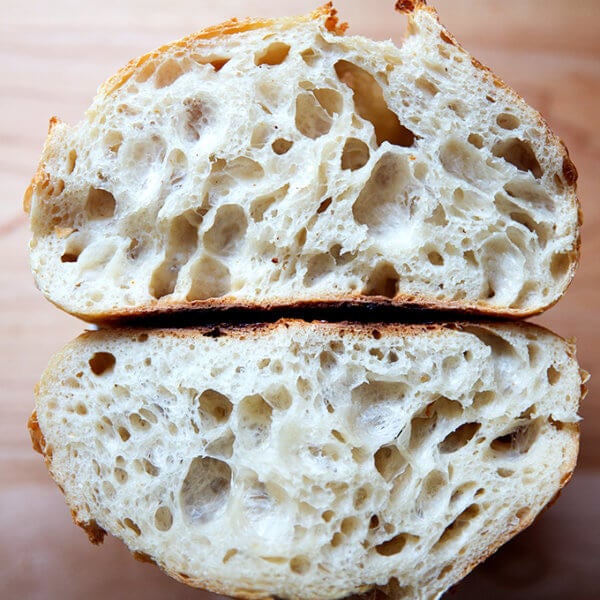
Homemade Sourdough Bread, Step by Step
- Total Time: 18 hours 45 minutes
- Yield: 1 loaf
Description
Inspired by The Clever Carrot
If you are new to sourdough, watch the step-by-step video here: Simple Sourdough Bread or in the post above.
Troubleshooting: If you have issues with your dough being too sticky, please read this post: Why is my sourdough so sticky? The 4 common mistakes.
Notes:
- You need an active sourdough starter. I have had success activating starters from:
- As always, I highly recommend investing in a digital scale before beginning any bread baking adventure.
- This is the Dutch Oven I use for sourdough bread. I used this Dutch oven for years, and it’s a great one, too.
- Flour sack towels are a great investment because they ensure your dough will not stick while it is proofing.
- I love using rice flour for dusting (as opposed to ap or bread flour) because it doesn’t burn. When you use a flour sack towel, however, you don’t need to use any flour.
- Find all of my sourdough essentials here: Essential Equipment For Sourdough Bread Baking
- I love a high-hydration dough, and I have great success using 380 grams of water in this recipe, so feel free to play around and push the hydration here.
- Salt: I have had success using both kosher salt and fine sea salt here. When I use kosher salt, I use the Diamond Crystal brand. When I use sea salt, I use the Baleine Fine brand. Regardless of the brand, I use 12 grams.
- Shaping: If you’re looking to get a more open crumb, try shaping a batard (as opposed to a round). Watch this video for guidance. Also: The recipe below follows the traditional shape once, rest, then shape again method. I often skip the preshape now and simply shape the dough once. I still get a nice open crumb.
How much Sourdough Starter to Use?
- Because my kitchen is cold for much of the year, I like using 100 g (1/2 cup) of starter as opposed to 50 g (1/4 cup). When determining how much starter to use, consider a few things: If you live in a warm, humid environment, 50 g should suffice. If you plan on doing an overnight rise, 50 g also should suffice. If you want to speed things up or if you live in a cold environment, consider using 100 g starter. Note: If you use 100 g of starter, your dough may rise more quickly, so keep an eye on it. As always, rely on the visual cues (increasing in volume by 50%) when determining when the bulk fermentation is done.
- A straight-sided vessel makes monitoring the bulk fermentation especially easy because it allows you to see when your dough has truly doubled.
Ingredients
- 50 – 100 g (1⁄4 – 1/2 cup) bubbly, active starter — I always use 100 grams, see notes above
- 375 g (1 1/2 cups plus 1 tbsp) warm water, or more, see notes above
- 500 g (4 cups plus 2 tbsp) bread flour
- 9 to 12 g (1.5 – 2.5 teaspoons) fine sea salt, see notes above
Instructions
- Make the dough: Whisk the starter and water together in a large bowl with a fork or spatula. Add the flour and salt. Mix to combine, finishing by hand if necessary to form a rough dough. Cover with a damp towel and let rest for 30 minutes.
- Stretch and fold: After 30 minutes, grab a corner of the dough and pull it up and into the center. Repeat until you’ve performed this series of folds 4 to 5 times with the dough. Let dough rest for another 30 minutes and repeat the stretching and folding action. If you have the time: do this twice more for a total of 4 times in 2 hours. Note: Even if you can only perform one series of stretches and folds, your dough will benefit. So don’t worry if you have to run off shortly after you mix the dough.
- Bulk Fermentation (first rise): Cover the bowl with a towel and let rise at room temperature, about 8 to 10 hours at 70°F (21°C) or even less if you live in a warm environment. The dough is ready when it has increased by 50% in volume, has a few bubbles on the surface, and jiggles when you move the bowl from side to side. (UPDATE: In the past I have recommended letting the dough rise until it doubles in volume. If you’ve had success with this, continue to let the dough double. Recently, I have been stopping the bulk fermentation when the dough increases by 50% in volume, and I feel I am actually getting better oven spring in the end.) (Note regarding timing: If you are using 100 g of starter, the bulk fermentation may take less than 8 to 10 hours. If you live in a warm, humid environment, the bulk fermentation may take even less time. In the late spring/early summer, for example, my kitchen is 78ºF and the bulk fermentation takes 6 hours. It is best to rely on visual cues (increase in volume by roughly 50%) as opposed to time to determine when the bulk fermentation is done. A straight-sided vessel makes monitoring the bulk fermentation especially easy because it allows you to see when your dough has truly increased in volume by 50%.)
- Shape (See notes above): Coax the dough onto a lightly floured surface. Gently shape it into a round: fold the top down to the center, turn the dough, fold the top down to the center, turn the dough; repeat until you’ve come full circle. If you have a bench scraper, use it to push and pull the dough to create tension.
- Rest: Let the dough rest seam side up rest for 30 minutes. Meanwhile, line an 8-inch (20-cm) bowl or proofing basket with a towel (flour sack towels are ideal) and dust with flour (preferably rice flour, which doesn’t burn the way all-purpose flour does). Using a bench scraper or your hands, shape it again as described in step 4. Place the round into your lined bowl, seam side up.
- Proof (second rise): Cover the dough and refrigerate for 1 hour or for as long as 48 hours. (Note: I prefer to let this dough proof for at least 24 hours prior to baking. See video for the difference in the crumb of a loaf that has proofed for 6 hours vs one that has proofed for 24 hours. If you choose to proof the dough in the fridge for an extended period of time, you may want to tuck it into a loosely tied bag — produce bags from the grocery store are great for this purpose — to ensure the dough does not dry out. The original recipe calls for a 1-hour rise, and if you have had success doing that, by all means, keep doing it.)
- Place a Dutch oven in your oven, and preheat your oven to 550°F (290°C). Cut a piece of parchment to fit the size of your baking pot.
- Score: Place the parchment over the dough and invert the bowl to release. Using the tip of a small knife or a razor blade, score the dough however you wish — a simple “X” is nice. Use the parchment to carefully transfer the dough into the preheated baking pot.
- Bake: Lower the oven to temperature to 450ºF (230ºC). Carefully cover the pot. Bake the dough for 30 minutes, covered. Remove the lid, lower the temperature to 400ºF (200ºC) and continue to bake for 10 – 15 minutes more. If necessary, lift the loaf out of the pot, and bake directly on the oven rack for the last 5 to 10 minutes. Cool on a wire rack for 1 hour before slicing.
- This loaf will stay fresh up to 3 days stored at room temperature in an airtight plastic bag or container. It freezes beautifully, too.
Notes
- This recipe has been adapted from Artisan Sourdough Made Simple. Changes I have made to the original recipe include:
- Using 11 g salt as opposed to 9 g.
- Performing 4 stretch and folds during the first 2 hours of the bulk fermentation, which build strength in the dough.
- Doing a cold proof for at least 24 hours before baking, which produces a lighter airier crumb. In the video, you can see the difference between the crumb of a loaf that has proofed for only 6 hours vs a loaf that has proofed for 24 hours.
- Finally, I like preheating my Dutch oven, which makes a crisper crust.
- Prep Time: 18 hours
- Cook Time: 45 minutes
- Category: Bread
- Method: Oven
- Cuisine: American
This post may contain affiliate links. Please read my disclosure policy.

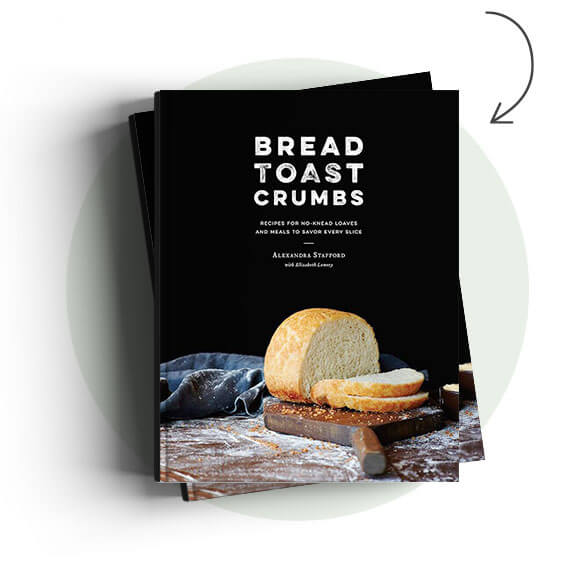




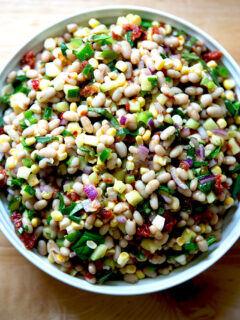
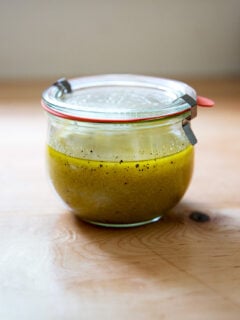



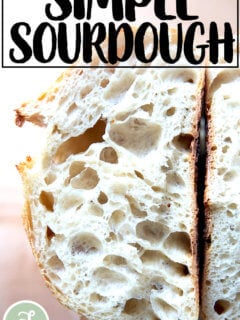
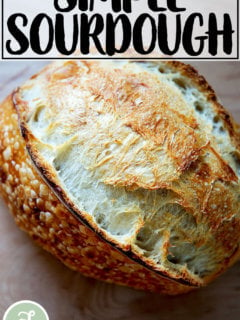
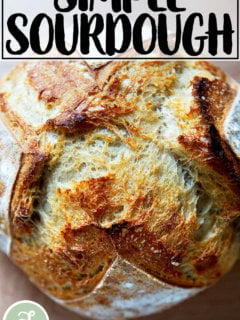
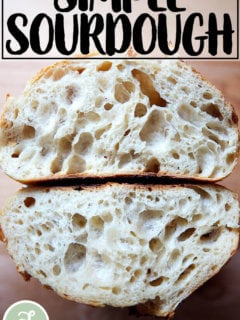
3,015 Comments on “Homemade Sourdough Bread, Step by Step”
I love this sourdough!! As long as you plan in advance, it’s super easy! Just one question: if I wanted to shape a batard, what size oval proofing basket would I need? I’ve only done round, but I’d really like to try a new shape! Thanks!
Hi! And apologies for the delay here. I use an 8.5-inch banneton. I love the shape of a batard!
Foolproof. It’s my go-to sourdough recipe. Thank you!
Great to hear, Sofia! Thanks so much for writing 🙂 🙂 🙂
Hi! This is my go to recipe for over a year every week! People love it. Question: could you cut it into 4 pieces at the time of the bench rest and then make into small little loaves cooking at less time?
Great to hear, Jess! And yes, absolutely. The cooking time will Definitely need to be reduced. I would just keep an eye on the loaves in the oven once you remove the lid from the Dutch oven.
What did you reduce the cooking times? Chill with the little loves?
By far my favorite recipe! I’m ready to start adding things into this recipe – jalapeño cheddar, garlic etc at what point in the process does this happen? I’m guessing right away but wanted to be sure. Thanks!
Great to hear Rebecca! You’ll want to add ingredients after you’ve done two sets of stretches and folds.
I am fairly new to sour dough bread. Your recipe is by far the best and easiest . Thank you so much .
Great to hear, Esma!
Life changing sourdough tips and recipe thank you Alexandra!!! Your shaping video was super helpful too! So happy with how my loaves are looking now!
Great to hear, Emma! Thanks so much for writing 🙂 🙂 🙂
Hands down the best recipe for sourdough. The walkthrough is thorough and very easy to follow. Definitely use this as your foundation! Thank you for sharing!
Great to hear, Tracy! Thanks so much for writing 🙂 🙂 🙂
I love this recipe. I made it 4 times so far. One loaf I messed up by using tap water for the bread dough. Luckily I used filtered for the starter. The rest came out perfect and delicious and the bread didn’t even last a day and a half. My go to. I find 2 teaspoons of salt to work perfectly and 100 grams of starter to be the perfect combination.
Great to read all of this, Drea :). Thanks so much for writing and sharing your notes.
Hi!
I was wondering if I could make this into a raisin type bread. What would be this best way to do this? or would it not work?
Thanks!
Yes, absolutely, go for it! Add the raisins after you’ve done one set of stretches and folds. Do at least two more sets of stretches and folds after you’ve added the raisins to ensure they disperse evenly throughout the dough.
Hello Alexandra, thank you for saving my life, and my bread. I am new to baking sourdough and have been frustrated by the learning process, till I found your website. You have made it so easy for me and at last my bread is turning out lovely. Thank you so much. Would you have some suggestions as to what to add to the bread, and when, thanks again.
So nice to read this, Tess 🙂 Thank you so much.
I would add ingredients after the second set of stretches and folds. Follow the second set by at least two sets of stretches and folds at 30 minute intervals and perhaps one more if the ingredients don’t like as evenly dispersed as you would like.
Hi! I love this recipe and I have been making it for months. I was wondering if you know why the bottom of my loaf tends to burn when the rest of my loaf looks great. What could be the best way to fix this? It is a light golden all around but the bottom always slightly burns. We still eat it and enjoy it!
Great to hear, Isabel! Here are some thoughts:
If you are using a preheated Dutch oven, consider lowering the temperature.
Before you make changes to the temperature, however, next time you bake, check the dough after 30 minutes. If the dough is browning too much on the bottom, you know that it’s happening during these first 30 minutes, in which case, you should lower the temperature from the start. Decrease it by 25ºF.
If the dough is not browning, then you know the burning is happening during the last 15-20 minutes of baking, in which case you could remove the loaf from the pot after 30 minutes and bake it on a sheet pan.
Another option: place your Dutch oven on two sheet pans. I do this with challah to prevent the bottom from burning. The extra layer of sheet pans will prevent the bottom of your sourdough from burning, too.
Another option: place your Dutch oven on a broiling pan.
Finally: Use rice flour for dusting — it makes all the difference. It does not burn the way wheat flour does. It also doesn’t coat the loaves with an unpleasant raw flour taste. One bag will last you a long time.
Thank you so so much for the response and all of the tips. I’ll test it out tonight
I love this recipe so much! It’s super thorough, I love the tips and have had great success. I’ve been playing around with the hydration too and it’s been amazing and so fun. Question for you. Have you tried doubling the recipe to make 2 loaves? Thanks!!
Great to hear, Miriam! Thanks so much for writing. You can definitely double this recipe. Just be sure you have a vessel large enough for the bulk fermentation. Otherwise, everything else is the same 🙂
This is the 2nd time I tried to bake ciabattas. I am one of those lockdown bakers and my starter (based on rye flour and some white bread flour) is now 2.5 years old. I was thinking I cannot bake ciabatta good enough but with your simple, straightforward method and video, the 2nd one turned out great today, just a few mins ago.
Just wanted to say thank you after thanking on Youtube : ) and wanted to ask if I need to remove them once the baking time ends or if the ciabattas need to stand in oven for a few mins?
So nice to read all of this 🙂 🙂 🙂 Thanks so much for writing and sharing your experience. Can you clarify your question? I’m not quite sure what you are asking. I think the answer is yes: remove the ciabatta from the oven once the baking time ends.
Hi Ali,
Thank you for your recipe. I am making it for the second time and my dough seems rather slack both times. I wonder if I am using a higher hydration starter than you typically use?
When I shape it after the bulk ferment it just slowly panckakes out and won’t hold it’s shape.
Do you have any suggestions?
Thank you!!
Hi Desirae!
Questions: are you using a scale to measure? What hydration starter are you using? I am using a 100% hydration starter, meaning equal parts by weight flour and water. How does your dough look after you mix it? Like the video? Or also very slack? The slackness is potentially due to overfermentation.
Hi Ali!
Yes I am using a scale. I think that my starter may be slightly greater hydration than 100%. What ratios do you use to activate your starter? Discard + Flour + Water? I think the discard I start the activation with is higher hydration just by how we maintain it. Do you have a video/ blog about maintaining your starter?
I just rewatched the video and I do think my dough looks wetter than yours and I notice that when I start my stretch and folds it is quite sticky and gets on my hands.
I appreciate your input!!
When I discard and refeed, I basically use about a tablespoon of the discard or less… it’s a tiny amount. So, my starter is almost exactly 50% by weight flour and water.
I don’t have a video on this on my site, but I do have a post: How to Feed, Maintain, and Store a Sourdough Starter
And this troubleshooting post might help as well.
I forgot to transfer my dough into my straight-sided vessel before doing the stretch and folds. I ended up plopping it in there after my fourth set and did my fifth one. Then I let do the bulk fermentation. Will this be okay? Or does doing the stretch and folds in the wrong place and then transferring it mess up the final result?
Absolutely fine! You can do the stretches and folds in whatever vessel you like.
Great step by step showing—specially the way put the dough into the oven when it ready to bake! Thank you so much for your skill
Nice to hear, Cecine! 🙂 🙂 🙂
I just made this for the first time. It came out so good! It’s a little on the heavy side which I suspect is down to my dough being too wet. I followed the instructions and didn’t want to deviate. Next time I will slightly reduce the amount of water I add to the mix. The bread is SO good. Can’t wait to make it again. Thanks for giving this sourdough newbie the confidence to do it again! 😍
Great to hear Jules! Yes, sourdough is all about trying things, making notes, and adjusting accordingly the next time around. Enjoy the journey! Thanks for writing 🙂 🙂 🙂
Alexandra – You have given us incredibly useful content! I’ve used your instructions and recipe many times and I’m slowly perfecting my bread. Each time I make a loaf, it’s a little bit better than the last. I’m so happy with my progress! Thank you for your generosity in sharing your knowledge with us.
So wonderful to hear this, Joyce! Isn’t sourdough fun? thanks for writing 🙂 🙂 🙂
I love this recipe. I always like to make 2 loaves when I make bread, and I put one in the freezer when cooled. I’ve never known whether I should double all the ingredients including the starter amount? Or would 100g starter work for twice the amount of flour and water in this recipe?
Thanks so much. I can’t wait to try more of your recipes.
Janet
Great to hear, Janet! I always double the starter if I make a double batch.
Third time using this recipe!!! The first time it didn’t work very well but I found my mistakes and now I am a pro (lol). Love it
Great to hear, Regina! Thanks for writing 🙂
Third time making this loaf. Oh my, it really is the very best! I purchased an elongated banneton, 13 3/4″ x 5 3/4″ (exterior measurements). The final shaping of the dough was adjusted to fit this banneton. A conventional Dutch Oven would not fit the configuration of my loaf. I used an old, large metal roasting pan that I purchased second-hand–I used the (deeper) bottom part of the roaster as its lid was too shallow in height. I positioned the roaster’s “bottom half” atop my baking stone, as one would with a DO, when preheating the oven.
The dough enjoyed a lengthy cold ferment–the oven spring on this loaf was AMAZING!!!
I mention the above particulars in the event that your readers may wish to opt for an alternate bread shape.
Thank you Alexandra, for sharing your wisdom and experience in this fun journey!
Elaine, thank you for all of this! I love the idea of making an elongated loaf — I’m still dying to make a good baguette (sourdough or yeast) at home — and I love that you were able to use a baking vessel you have on hand to get the job done. I have an old metal roasting pan that I think would work well here. Thank you so much for writing and sharing your notes — so helpful for others indeed.
This is my go to recipe!!! What do you use to store your loaves at room temperature? I’ve heard brown bags or freezer bags are there any nicer looking alternatives for gifting and staying fresh?
I wish there were an attractive option! Honestly, I think a ziplock bag is the best way to store bread and keep it fresh.
Made this loaf yesterday and it came out perfect. I only let it rise in the refrigerator for 6 hours. The crumb was very open and it was fantastic! Next time I will plan appropriately and let it stay in the refrigerator for closer to 24 hours. Thank you for such a great recipe with clear directions. I have had my starter for 5 months, but this is my first loaf of true sourdough bread. I was scare of success as I have read it can be difficult, but you made it seem easy.
So great to read this! Wonderful to hear about your open crumb given the relatively short fridge time. Thanks so much for writing and sharing your notes. So helpful for others!
Hi, made this excellent recipe many times but I always use the stand mixer and then do stretch and folds. Just meant to ask if the stand mixer is used should I skip the stretch and fold method since gluten develops much quicker or should it be done anyway? Thank you!
I think you could probably skip the stretch and folds! I’ve never tried so I can’t say, but I would experiment without doing the folds bc that will save you time in the long run.
What would be the reason to lift the bread out and bake directly on the over rack? I’ve made this recipe loads of times and love it, but just noticed that note and was curious-too browned on bottom? Not browning enough?
Hi Emily! Great to hear. Yes: too browned on the bottom due to the hot cast iron Dutch oven.
So excited to try this recipe! Question, if i wanted to split this in half after the bulk rise to make 2 smaller loaves would that affect the proof time in the fridge? Or would i still leave them in them in for approx 24hrs.
Thanks so much!!
It won’t affect the proof time! Good luck 🙂
Wonderful! This was my first successful sourdough loaf, can’t believe how well it came out! Really clear instructions without being overwhelming, thank you so much.
Great to hear, Ben! Thanks so much for writing 🙂 🙂 🙂
Hello
Can I use AP Flour instead of Bread Flour?
Yes!
Can you freeze it at the last proofing stage? I quite like freshly baked sourdough and usually make this from 1.5 ingredients and have two smaller loaves. I freeze one of them after baking but obviously the crust is never as good as when it’s freshly baked… So just wondered whether you can freeze it at certain stage before baking.
Hi Anna,
I have not tried this, but my experience when freezing unbaked sourdough pizza dough is not great — the crust is never as bubbly. I’d hate for you to go through with the process only to have a super dense loaf in the end.
I’ve been baking sourdough for over 4 years now, always trying out different recipes. I just pulled a loaf made with Ali’s recipe here out of the oven this morning and it’s literally the best one I’ve ever made. I’m 100% sold on this method. I love the easy kneading process and the airy, open-crumb result (I didn’t even know that term before I found this). My husband loves it too. We’re baking a loaf for each side of the family at Christmas. Please try this recipe, and watch Ali’s video of her doing it first so you can see the texture of her dough. Mine was much wetter for some reason but still turned out amazing.
So nice to read all of this, Summer! Thanks so much for writing and sharing your experience. Happy holidays!!
Bam! This was my first ever loaf of sourdough bread and it came out amazing! The directions and videos are so clear and helpful. I did an 18 hr second proof and the crumb was lovely! For years I’ve been intimidated at the thought of making sourdough bread-thank you Alexandra for making this so do-able! You’re making sourdough dreams come true for this baker in Alaska. 🙂 Zoya
Wonderful to read this, Zoya! Thanks so much for taking the time to write. I love hearing this 🙂 🙂 🙂 🙂